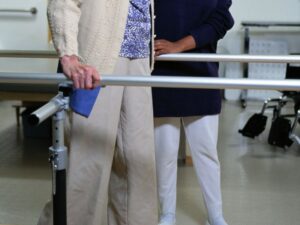When I first looked at Newsweek’s recent list of America’s Best Physical Rehabilitation Centers 20211. I knew there was something wrong in Wisconsin. Even at first glance it was apparent that Wisconsin was scoring lower than the other States. As a physical therapist living and working in Wisconsin, that’s a concern: no healthcare provider wants to think that the care they’re offering patients isn’t up to scratch compared to other providers. So I looked a little closer. That’s when I became really concerned.
Newsweek partners with global market research firm Statista Inc. to annually produce a list of the best Medicare and/or Medicaid Inpatient Rehabilitation Facilities (IRFs) in the United States. Not all States are represented, nor are all IRFs. The main inclusion criteria were:
- States with the most IRFs – as defined by the Centers for Medicare and Medicaid Services (CMS) – were included: 25 in 2021, increased by 5 from the previous year; and
- facilities had to meet the CMS definition of an IRF, ie: “IRFs are free standing rehabilitation hospitals and rehabilitation units in acute care hospitals. They provide an intensive rehabilitation program and patients who are admitted must be able to tolerate three hours of intense rehabilitation services per day.”2. CMS does not include Skilled Nursing Facilities (SNFs) nor home-based rehabilitation services in this definition3. and are assumed not to be included in the study.
Facilities were scored using several measure: a reputation score (based on surveys which included questions about facilities quality of initial and follow-up care, quality of service, and accomadation/amenities), a KPI score (based on CMS data) and bonus scores from Commission on Accreditation of Rehabilitation Facilities (CARF) accreditations and Model Systems awards in spinal cord, traumatic brain, and/or burn injuries as awarded by the National Institute on Disability, Independent Living, and Rehabilitation Research (NIDILRR). The final scores were weighted: 45% Reputation, 45% KPI, and up to 5% each for CARF and Model Systems, to give a final percentile score. Facilities were then ranked by State according to their total score. The top 20% of facilities (or the top 5 facilities where 20% resulted in less than 5) were included in the final listings for a total of 230 facilities across the 25 States represented. More details methodology can be found in the article and on Newsweek’s website.
Wisconsin had 5 facilities listed as the best in the State according to the inclusion criteria. The article suggests, though does not specify, that this represents more than 20% of the total included facilities in Wisconsin, likely due to a smaller number of facilities that met the inclusion criteria.
According to the results, Wisconsin facilities ranked on average the second lowest (70.3%) of the 25 States, only beating the lowest State (Alabama averaged 69.4%) by a less than 1% margin. Wisconsin’s top ranked facility scored 71.0%, which was the lowest score for a top ranked facility compared to other States. Further, this facility’s score was lower than the top 5 facilities’ scores of 17 other States, and lower than the bottom ranked facilities of 6 other States. It would seem that Wisconsin’s best would not even make the grade in some other States.
One (barely) saving grace: Wisconsin’s lowest scoring facility (69.1%) was better than the lowest scoring facilities of 3 other States (2 if you only consider the top 5 ranked facilities in each State).
Even more interesting is when you look closer at the scores, you can see that there isn’t much difference between facilities in Wisconsin. The difference in scores between the first and fifth ranked facilities in Wisconsin is only 1.9%. The next lowest was South Carolina at 4.2%. While it would take detailed statistical analysis to determine if this is significant, such a small variance does suggest that whatever is happening in Wisconsin, it’s a Statewide phenomenon that cannot just be attributed to a specific facility/organization.
So what does it all mean? Is inpatient rehab in Wisconsin really that much worse than the rest of the country? And if so, why?
Before we jump to any conclusions there’s a couple of considerations we have to make.
The first is to recognize that the study is limited in terms of its design and scope. The inclusion criteria is very specific and likely excludes many facilities and providers, like SNFs, who provide inpatient rehabilitation services; who may in fact be more involved in providing inpatient rehab to the communities they service than hospitals. Though there is argument that hospital-based inpatient rehab is different to SNF-based inpatient rehab (intensity, acute versus sub-acute, etc.), other factors, for example the lower cost of providing inpatient care in a SNF setting versus a hospital setting may mean more patients – especial Medicare and Medicaid patients – are receiving inpatient services outside of those facilities included in the study, and the exclusion of these services may be skewing the results.
Another consideration is the way in which the data was obtained, particularly the reputation score. According to the methodology3. surveys were conducted with “medical experts (physicians, therapists, medical doctors, administration & staff working in physical rehabilitation facilities)” who were asked to “name up to five of the best physical rehabilitation centers in their respective state. They were asked to recommend physical rehabilitation facilities by considering the quality of care, quality of service, quality of follow-up care and accommodations & amenities” (pg 3). My first question upon reading this was: what about the patients? The people who are on the receiving end of these services? Surely it’s their opinions that matter most when it comes to understanding quality of care, service, accommodations and amenities. That aside, it would seem these surveys are about opinion rather than actual outcomes or other measurable variables, and therefore their validity must be questioned in terms of the amount of bias skewing the results. Although other measurable variables (eg: KPI data) were included in calculating the final score, the reputation score represents a significant portion (45%) of the final score, leaving a lot of any given facility’s ranking dependent on opinion – and not the opinion of those receiving the services – as opposed to than actual outcomes.
So while it might not be fair to make a blanket statement that inpatient rehab in Wisconsin isn’t as good as that in other States, when we compare apples to apples, it does seem that under the criteria of this study Wisconsin is falling behind other States. If this is accurate, it’s important to discover and understand why.
First instinct would be to question the quality of care providers: are Wisconsin’s medical personnel as good as those in other States? As a physical therapist in Wisconsin, and at the risk of demonstrating extreme bias, I would have to answer, yes! In my almost 7 years here (and nearly 20 as a PT) it’s been my privilege to have worked with some of the best therapists, therapy assistants, nurses, CNAs and other associated staff as I ever have throughout my career. Coupled with comparable education and licensing requirements to other States, I cannot believe this – or at least this alone – would be the reason. However, until we know for a fact it isn’t, it still bears investigating, if only in the process of doing so we discover best models of practice which would further improve the level of care provision in inpatient rehab.
If not the providers, then what? Could it be an issue of organizational management, culture, policies or practices? Could it be an institional or Governmental issue in relation to the administration of the healthcare system itself? Could there be some other factor that somehow negatively biases Wisconsin’s results?
The short answer is: yes. It could be any or all of these things. We won’t know until we start delving deeper into the delivery of Wisconsin’s inpatient rehab services.
A better question might be: who’s going to look into it?
Or even better: who’s going to do something about it?
References:
1. Cooper, N. (2021). America’s Best Physical Rehabilitation Centers 2021. In Newsweek, 177(7): 30-39
2. CMS. (2012). Inpatient Rehabilitation Facilities. Accessed on 29 September 2021 via: https://www.cms.gov/Medicare/Provider-Enrollment-and-Certification/CertificationandComplianc/InpatientRehab
3. The Medicare Resource Center. (2021). What is an inpatient rehabilitation facility? Accessed on 29 September 2021 via: https://www.medicareresources.org/glossary/inpatient-rehabilitation-facility/


